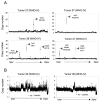Oncogenic BRAF mutation with CDKN2A inactivation is characteristic of a subset of pediatric malignant astrocytomas
- PMID: 20068183
- PMCID: PMC2851233
- DOI: 10.1158/0008-5472.CAN-09-1851
Oncogenic BRAF mutation with CDKN2A inactivation is characteristic of a subset of pediatric malignant astrocytomas
Abstract
Malignant astrocytomas are a deadly solid tumor in children. Limited understanding of their underlying genetic basis has contributed to modest progress in developing more effective therapies. In an effort to identify such alterations, we performed a genome-wide search for DNA copy number aberrations (CNA) in a panel of 33 tumors encompassing grade 1 through grade 4 tumors. Genomic amplifications of 10-fold or greater were restricted to grade 3 and 4 astrocytomas and included the MDM4 (1q32), PDGFRA (4q12), MET (7q21), CMYC (8q24), PVT1 (8q24), WNT5B (12p13), and IGF1R (15q26) genes. Homozygous deletions of CDKN2A (9p21), PTEN (10q26), and TP53 (17p3.1) were evident among grade 2 to 4 tumors. BRAF gene rearrangements that were indicated in three tumors prompted the discovery of KIAA1549-BRAF fusion transcripts expressed in 10 of 10 grade 1 astrocytomas and in none of the grade 2 to 4 tumors. In contrast, an oncogenic missense BRAF mutation (BRAF(V600E)) was detected in 7 of 31 grade 2 to 4 tumors but in none of the grade 1 tumors. BRAF(V600E) mutation seems to define a subset of malignant astrocytomas in children, in which there is frequent concomitant homozygous deletion of CDKN2A (five of seven cases). Taken together, these findings highlight BRAF as a frequent mutation target in pediatric astrocytomas, with distinct types of BRAF alteration occurring in grade 1 versus grade 2 to 4 tumors.
Conflict of interest statement
Figures




References
-
- van’t Veer LJ, Bernards R. Enabling personalized cancer medicine through analysis of gene-expression patterns. Nature. 2008;452:564–70. - PubMed
-
- Raffel C, Frederick L, O’Fallon JR, Atherton-Skaff P, Perry A, Jenkins RB, James CD. Analysis of oncogene and tumor suppressor gene alterations in pediatric malignant astrocytomas reveals reduced survival for patients with PTEN mutations. Clin Cancer Res. 1999;5:4085–90. - PubMed
-
- Pollack IF, Hamilton RL, James CD, et al. Rarity of PTEN deletions and EGFR amplification in malignant gliomas of childhood: results from the Children’s Cancer Group 945 cohort. J Neurosurg. 2006;105:418–24. - PubMed
Publication types
MeSH terms
Substances
Grants and funding
LinkOut - more resources
Full Text Sources
Other Literature Sources
Medical
Molecular Biology Databases
Research Materials
Miscellaneous

